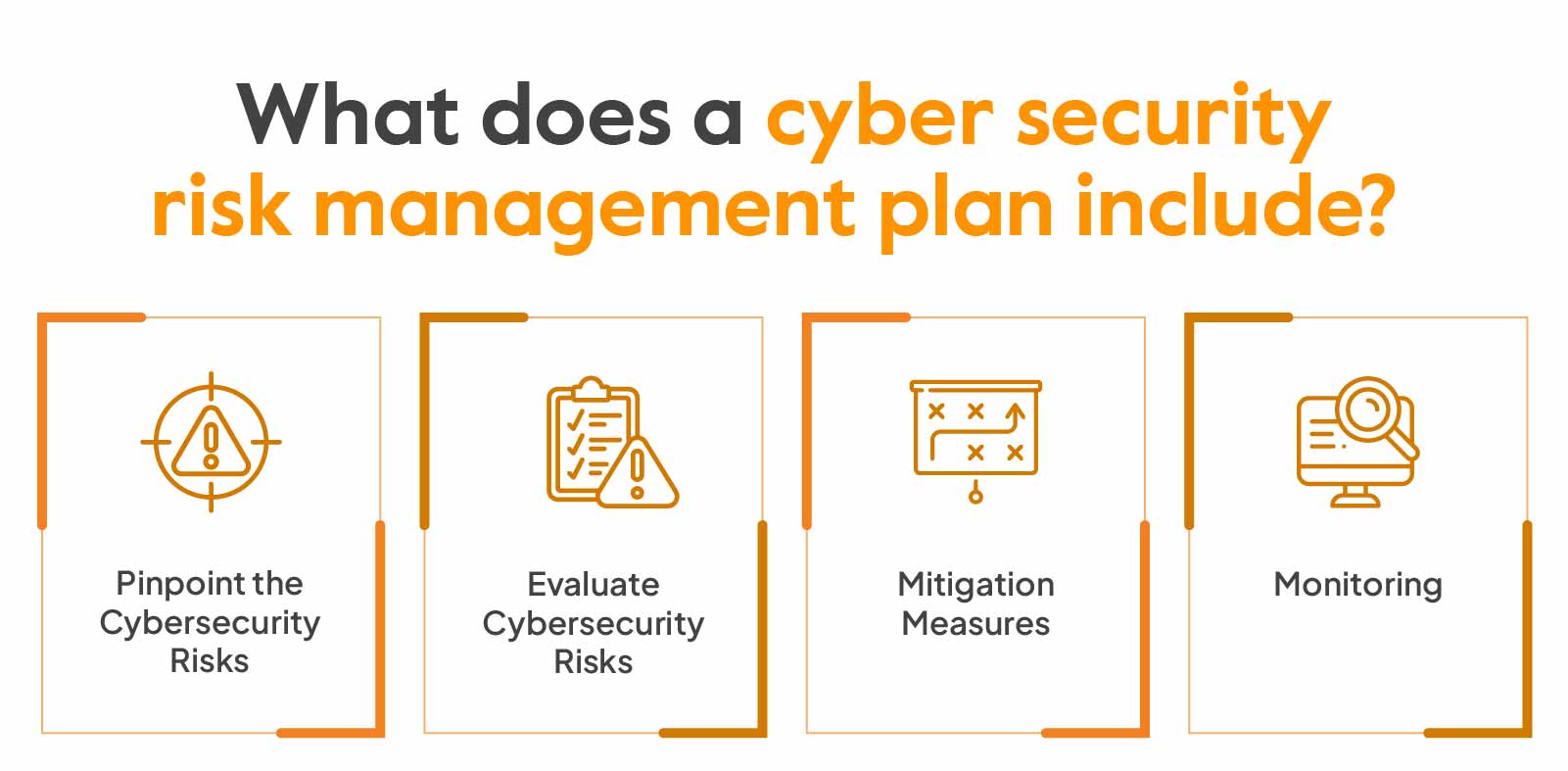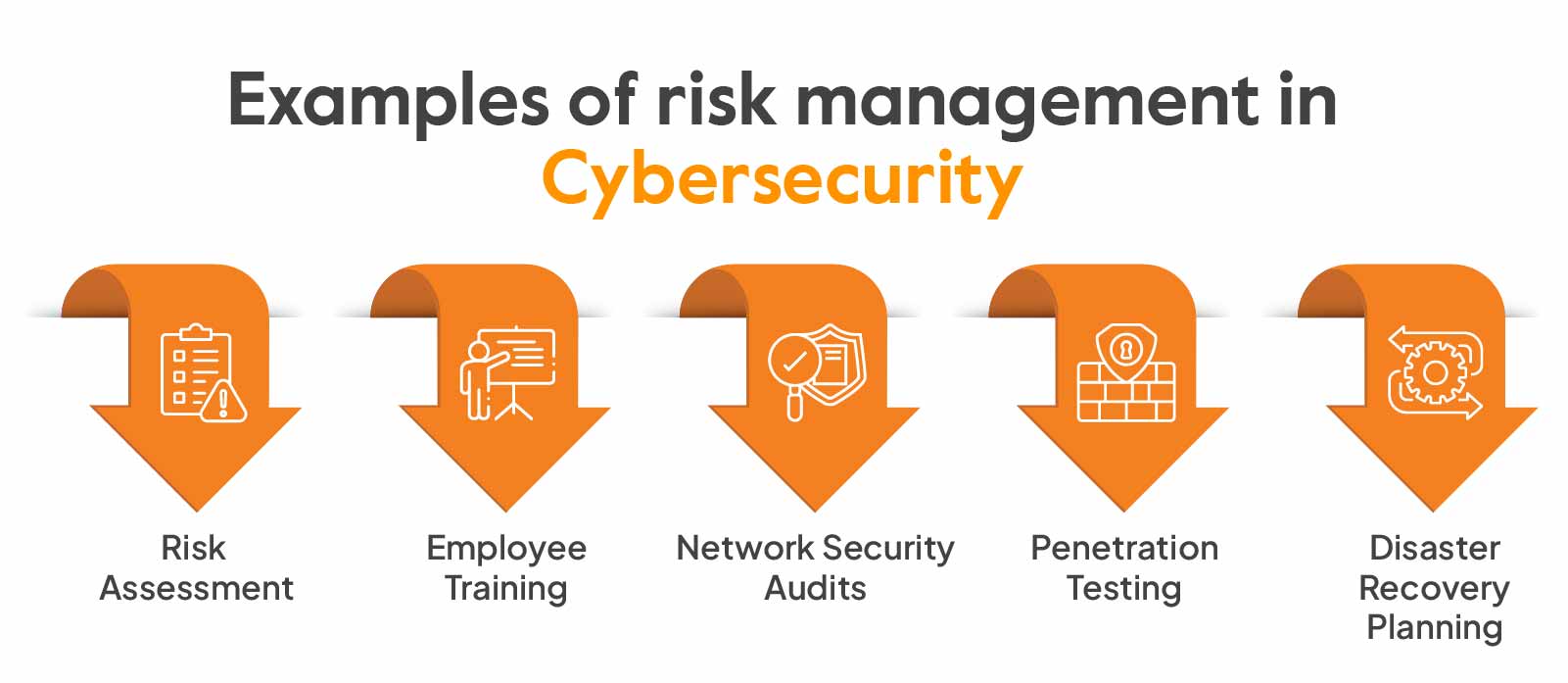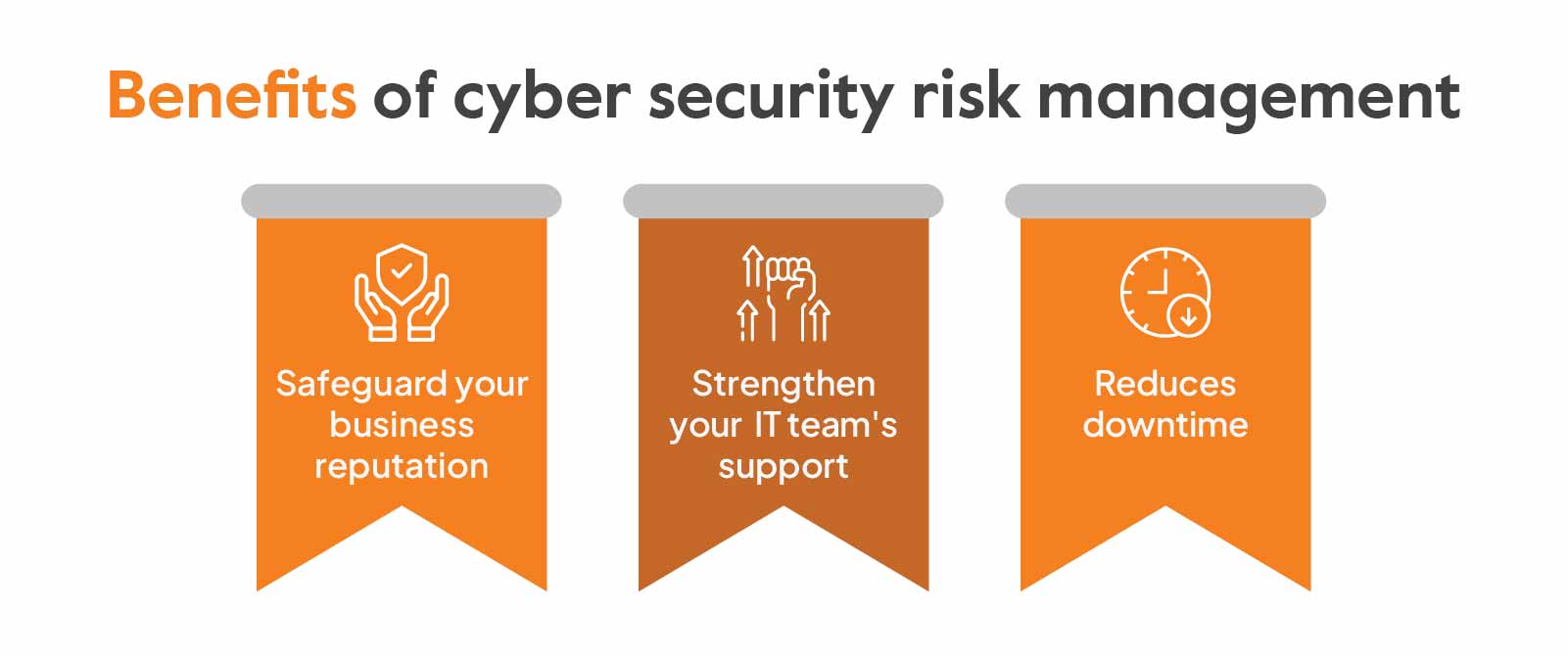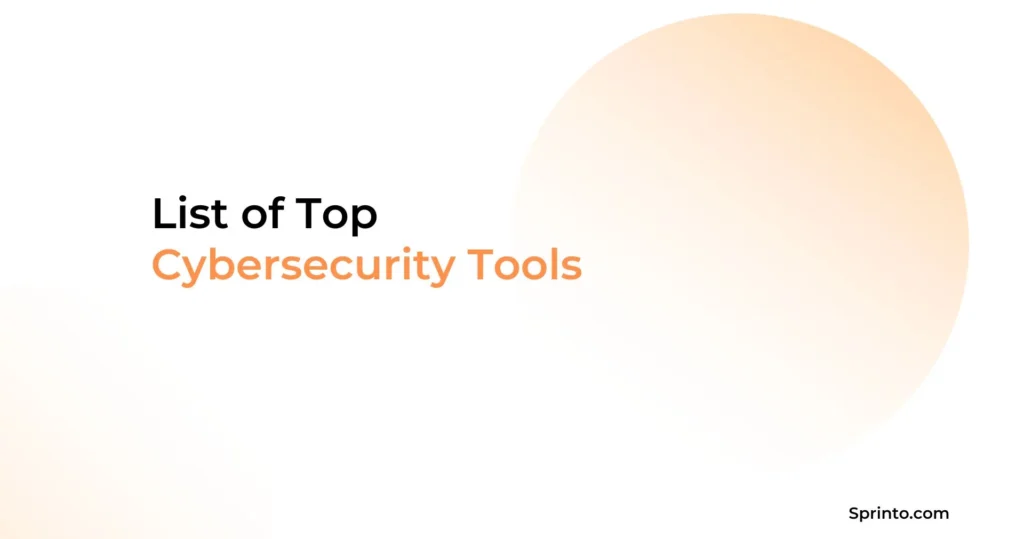
When it comes to staying safe online, cyber security risk management is the key. But the idea of creating a thoughtful plan and process may sound intimidating—especially if you’re unsure where to begin.
That’s why we’ve taken the time to research and outline what a cybersecurity risk management process is and why it is important. This way, you can take actionable steps to protect yourself in today’s digital world.
Let’s dive in…
What is Cybersecurity Risk Management?
Cybersecurity risk management is the process of implementing measures that help organizations mitigate the impact and reduce the probability of cyber risks. It involves identifying risks relevant to your business, analyzing and assessing their impact, prioritizing risks according to their severity, and taking corrective action that helps mitigate damage and ensure continuity when such risks occur.
Cybersecurity isn’t about eliminating risks—it’s about managing them. The goal of cybersecurity isn’t to create an impenetrable defense, but to reduce the liability and impact of threats lurking in the environment, ensuring business continuity even in the case of an incident.
Now that you get the idea, let’s dive deeper!
Cybersecurity risk management process
As discussed earlier, organizations typically manage risk through a four-step process – identification, analysis, evaluation, and mitigation. Here’s what each of these steps entails:
Identification
The first step involves identifying internal and external risks that may affect the reputation or continuity of the business, such as ransomware attacks and DDoS attacks. This includes discovering assets, evaluating attack pathways, and recognizing the attack surface.
Analysis
Once risks are identified, they are further assessed for their impact and likelihood. This insight helps an organization realize their biggest risks first and identify the most vulnerable links in the chain.
Evaluation
Once risks are analyzed based on their impact and likelihood of occurrence, businesses must prioritize the risks as per the severity and evaluate the residual risk based on control effectiveness. This step also helps in deciding which risks require immediate attention and which can be monitored over time.
Address
As the final step, an organization must decide what amount of residual risk is acceptable, which risks can be transferred, and which risks can be eliminated. For the risks that need reduction or elimination, effective controls should be implemented, and their performance should be monitored in real-time for continuous improvement.
Key Components of Cybersecurity Risk Management
An effective cybersecurity risk management program should entail the following three components:
- Robust policies and tools: To ensure that organizations stay protected from internal and external threats, they must surround themselves with robust policies and tools to assess vendor risk and identify emergent risks such as new regulations with business impact.
- Training program: Ensuring that gaps in IT security are identified, addressed, and mitigated through training programs is critical to developing and maintaining a solid security posture.
- Vendor risk management: Documentation of vendor risk management and security should always be updated for regulatory examination or to appease prospective customers.
Sprinto helps you implement a comprehensive risk management program by covering all key components using smart automation.
- Offers the tools to build a fully connected and highly automated risk management program.
- Trains your employees and collects evidence of completion in an audit-friendly way.
- Automates new vendor discovery and manages associated risks throughout vendor lifecycle with full control and confidence
Effortless, Efficient Risk Evaluation
How to build a cybersecurity risk management plan
A cybersecurity risk management plan is a strategic process that helps prioritize and address threats by continuously identifying, analyzing, and evaluating cybersecurity risks within an organization. It includes maintaining a risk register with an impact score of risks, prioritizing them, and documenting mitigation and incident recovery protocols.
You can build a complete cybersecurity risk management plan by implementing these four steps mentioned below:

1. Pinpoint cybersecurity risks
With so many potential threats, the modern security team faces an uphill battle regarding risk identification. After all, Gartner defines IT risk as “the potential for an unplanned, negative business outcome involving the failure or misuse of IT.”
Essentially, this deciphers if any existing threats target a given vulnerability but also measures the direness of the outcome should an attack be successful.
The risks may be hidden or hard to determine on the surface—but identifying them is always the first step.
Threats lurk in seemingly innocuous places—including hostile attacks, human errors, structural or configuration failures, and natural disasters. All of these can potentially bring about serious negative effects on an organization’s operations or assets.
Vulnerabilities that allow these threats to slip through cracks often stem from inadequate data security measures internally within the organization and from external sources like supply chains or vendor relationships. And this is all before discussing the consequences of successful exploitation of these vulnerabilities, which often far outweigh their level of impact and cause significant damage or financial loss.
Understanding the relationship between threats, vulnerabilities, and consequences is essential for organizations to protect themselves from these detrimental events.
2. Evaluate cybersecurity risks
Assessing cybersecurity risks is an essential task for any organization. It’s not just about keeping data safe; it’s also about encouraging communication and collaboration between team members while they take steps to manage the risk.
When you assess the risk within your organization, you can identify the assets and prioritize their importance, plus identify any threats or vulnerabilities that could impact your system.
From there, develop controls to mitigate those risks and determine the likelihood of a threat event occurring. The resulting risk determination will help provide crucial insight into your organization’s well-protectedness.
Taking risk assessment seriously can protect valuable data and resources while strengthening team cooperation — a win-win for any company.
You can evaluate the risks in your environment using the following steps:
- Identify assets: Identifying your assets such as endpoints, IoT devices, networks, servers, hard drives, and more. This includes both cloud hosted and on-premise assets.
- Prioritize the assets: Create an inventory to keep track of everything and prioritize based on its importance. Assign a value to know the impact of its loss.
- Identify threats: Now that you have identified the assets, identify the threats based on the asset type. For example, physical devices can be stolen while data deployed on clouds can be compromised by cyber attacks.
- Identify vulnerabilities: Identifying the security loopholes and vulnerabilities is the first step to minimizing the negative impact on your organization’s assets and making informed decisions to reduce the attack surface.
- Identify recurrence: After implementing the controls, monitor the effectiveness of their performance to ensure it meets the compliance requirements and functions so that an incident does not occur again.
- Conduct an impact assessment: Once you have identified the risks in your environment, list the options for mitigating the risks or reducing their impact. These include controls like firewalls, encryption, anti-malware solutions, multi-factor authentication, and more
Build true risk resilience
Sprinto empowers you to analyze risks and evaluate their impact based on the level of risks. It seamlessly integrates with your cloud stack to identify misconfigurations and vulnerabilities. Build a comprehensive risk register and an accurate risk profile to manage security risks in alignment with your acceptable level and risk tolerance. Get a demo now.
3. Mitigation measures
Once you’ve identified and assessed risks to your organization, the next step is to develop a strategy for mitigating those risks. This calls for an understanding of available options, which often entails a combination of technological solutions like encryption, firewalls, threat-hunting software, and automation—along with best practices designed to meet organizational needs.
A team with a comprehensive plan will always be the most successful at proactively managing risk. History has demonstrated that the organizations that are successful in this effort can really consider their mitigation response and manage any remaining risk effectively.
Some of the best practices include:
- Businesses take a multipronged approach to risk mitigation, and sound practices can significantly reduce anxiety about security threats.
- Cybersecurity training programs, along with up-to-date software
- Privileged access management solutions, multi-factor authentication, and dynamic data backup are all essential components of an effective strategy
4. Monitoring
With changes happening around us at the speed of light, monitoring the IT environment is paramount to ensure your organization complies with risk-assessment guidelines and internal controls.
A good monitoring system is like an attentive sentry guarding your organization. Regularly scanning for regulatory changes, keeping tabs on vendors, and understanding how your teams use technology will help you stay one step ahead of any potentially troublesome gaps.
Keeping an eye on these three elements of your IT environment will allow you to identify risks before they manifest, like a hero warning castle inhabitants of an imminent attack.
Automate continuous monitoring
Sprinto simplifies the deployment, testing, and monitoring of customized security frameworks and unique controls designed specifically for your business needs. With Sprinto, you can conduct comprehensive risk analysis, implement tailored security controls, and automate workflows to ensure comprehensive compliance coverage. Get a demo now.
Examples of Risk Management in Cybersecurity
Here are some cybersecurity risk management example:

Risk assessment
Risk assessment is one of the most crucial steps in a comprehensive risk management plan for cybersecurity. This process involves identifying, analyzing, and evaluating risks potentially threatening the organization’s assets and networks.
Employee training
Cybersecurity education and awareness training are vital components of a risk management plan. Providing employees with the knowledge they need to identify potential threats can help protect the organization from becoming a victim of cyber-attackers.
Essential employee training topics include password security, email best practices, data protection measures, and understanding phishing tactics.
Network security audits
Regular audits of an organization’s network can effectively detect vulnerabilities or unauthorized access attempts before they become a significant threat. An audit will review all components of an information system – from hardware to software.
And they look for any possible weaknesses that attackers could exploit. After identifying any issues, organizations can take steps to remedy them before damage is done.
Automate continuous monitoring
Sprinto helps you deploy auditor-level security programs to demonstrate compliance with standards such as SOC 2, ISO 27001, and PCI. Seamlessly integrate your cloud infrastructure for automated workflows and swift gap detection. Define a dedicated audit window within monitoring periods to ensure focused compliance monitoring separate from other activities. Get a demo now.
Penetration testing
Penetration testing is another valuable tool for assessing an organization’s security posture against potential cyber threats by simulating attacks on systems and networks to discover any existing vulnerabilities or weaknesses that must be addressed before real-world attackers find them first.
Disaster recovery planning
To ensure continuity of operations after a cyber attack occurs, organizations should have robust plans in place for responding quickly and restoring operations as soon as possible following an incident.
This includes having appropriate backup systems in place and detailed instructions on restoring systems quickly if needed to minimize downtime and other impacts on the business operations caused by a successful attack.
Also, refer to: Best ERM software
“Risk is something which is common sense and we do it every day. It is also core to frameworks like ISO. If you find a good system that helps you translate that risk into the way your business runs, then you can do well as a risk function.”
Girish Redekar, Co-Founder at Sprinto
Great advice adds up. Get more from the brightest minds in GRC — Subscribe to our newsletter
Standards and framework that require a cyber risk management approach
Generally, standards and frameworks that revolve around information security, data privacy, and cloud security include a risk management approach. These include:
- NIST Cybersecurity Framework (CSF): Outlines policies on how private sector organizations can assess and improve their ability to prevent, detect, and respond to cyberattacks, emphasizing risk management through its five core functions: Identify, Protect, Detect, Respond, and Recover.
- ISO/IEC 27001: An international standard that guides organizations to manage, monitor, and maintain information security posture. It ensures that organizations have a robust ISMS to confirm the confidentiality, integrity, and availability of the organization’s information.
- SOC 2: SOC 2 is a framework designed for service providers that store customer data in the cloud. It helps organizations implement controls that ensure security, availability, processing integrity, confidentiality, and privacy of a system, mandating the identification, assessment, and mitigation of security risks.
PCI-DSS (Payment Card Industry Data Security Standard) – the framework focuses on protecting cardholder data and requires regular risk assessments to identify vulnerabilities and threats in the payment card environment.
Benefits of Cybersecurity Risk Management
Risk management offers numerous benefits, allowing you to satisfy your security objectives and performance goals quickly. Here are a few advantages of incorporating an effective cybersecurity risk management strategy:

Safeguard your business reputation
Imagine a major data breach. You can picture the headlines, the news stories that warn of cyber-attacks, and the devastating effects this can have on your company’s reputation.
After all, who wants to entrust their confidential data or information to a business that couldn’t protect it in the first place?
Organizations need to have a robust cyber risk management program in place to avoid becoming an example of what not to do in cyber security. With plans to detect and respond quickly to threats, teams can help maintain a good reputation and restore customer trust.
Strengthen your IT team’s support
If you introduce proactive security-focused strategies such as having a cybersecurity plan and risk management plan, your IT team can have less of a weight on their shoulders.
An adequate number of personnel and resources will be available for projects and IT services, avoiding those dreaded work-from-home scenarios due to unforeseen crises.
From the IT staff’s overall morale perspective, involving the team in creating the risk management plan may be beneficial.
Everyone wins when an understanding of tasks and potential risks can be established. With a secure foundation, your team can focus more on delivering greater results than attempting to battle through emergencies.
Reduces downtime
All too often, stories arise of businesses succumbing to debilitating attacks that cause an extended amount of downtime, causing hardship for company employees and driving up financial costs.
According to ITIC’s Hourly Cost of Downtime Survey, 44% of businesses reported that hourly downtime costs exceeded $1 million to over $5 million, excluding legal fees, fines, and penalties – an example of how damaging these downtimes can be.
When operations are delayed, it can cause a cascade of issues, including bottlenecks in workflow, an erosion of productivity, and disruptions to both internal & external communication.
What’s next?
The many cyber threats that your company might face every day and how you manage them effectively are important for your business continuity. Therefore, establishing a cybersecurity risk management plan will save your business and protect your reputation.
Sprinto helps manage your critical data and assets with an automated platform. You will get a comprehensive view of security posture risks, detect potential gaps, and prioritize proper remediation.
- Determine the likelihood of a risk failure using industry best practices to clearly scope them out
- Distill your residual risk load and add/remove risks as you grow
- Implement checks to mitigate risks and set up monitored checks
- Define roles and assign responsibility for each risk from the dashboard
Get in touch with us now to provide an extra layer of security to the functions of your business.
FAQs
Why is cybersecurity risk management important?
Companies have cyber security risk management to handle critical threats promptly. Through this method, you can detect, scrutinize, assess, and address threats based on the impact they may cause.
What are the three types of risk in cyber security?
Protecting your institution from the harmful effects of cyber threats should be a top priority. To do so, you must understand and prepare for malware, ransomware, and DDoS attacks.
What is an example of cybersecurity risk?
Cybersecurity risk encompasses an organization’s susceptibility to losses due to a malicious cyber incident, which could include but is not limited to ransomware, phishing attacks, malware infiltration, and third-party risks.
Meeba Gracy
Meeba, an ISC2-certified cybersecurity specialist, passionately decodes and delivers impactful content on compliance and complex digital security matters. Adept at transforming intricate concepts into accessible insights, she’s committed to enlightening readers. Off the clock, she can be found with her nose in the latest thriller novel or exploring new haunts in the city.
Explore more
research & insights curated to help you earn a seat at the table.




















